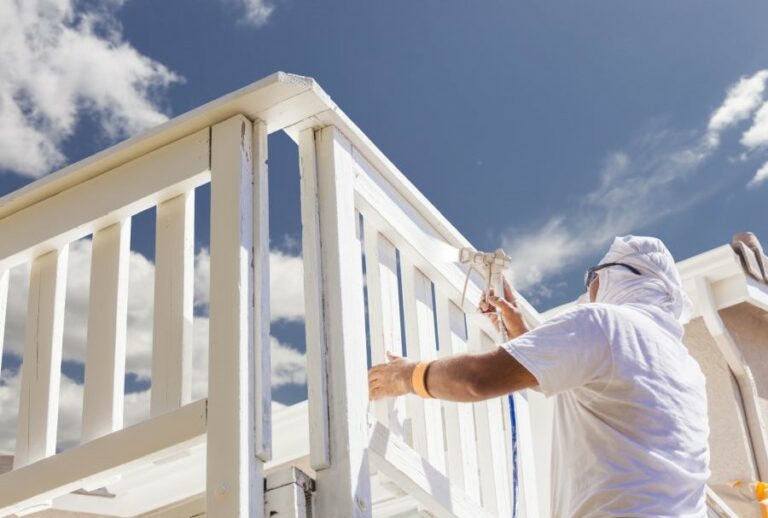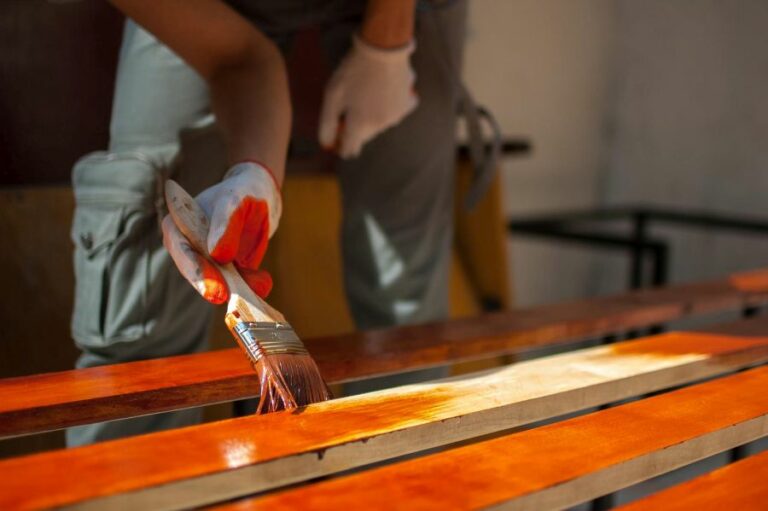How To Restore/Paint A Concrete Outdoor Statue
Are you looking to breathe new life into a worn or weathered concrete outdoor statue? You’ve come to the right place! We have the perfect guide to help you restore and paint your cherished piece, giving it that much-needed makeover. With our step-by-step tips, you’ll learn not only how to revitalize the statue but also how to protect it from future damage.
How to restore/paint a concrete outdoor statue:
To restore and paint a concrete outdoor statue, first prioritize safety by wearing protective gear. Assess the statue’s condition, gather necessary materials, and clean the statue. Repair any damage using concrete patching material or epoxy. Lightly sand the surface and wipe away dust. Optionally, apply a primer for durability. Paint the statue using outdoor acrylic paint, working from large areas to smaller details. Finally, apply a protective concrete sealer to prolong the paint job and protect it from weathering.

Does your concrete outdoor statue look dull and damaged? Learn expert tips and techniques to restore and paint it like a pro! Bring life back to your garden with a stunning makeover. Read on to explore our step-by-step guide.
Contents
- 1 A Comprehensive Guide on Restoring and Painting Concrete Outdoor Statues
- 2 What is the process for restoring outdoor cement sculptures?
- 3 What are the Steps to Repaint a Concrete Statue?
- 4 What is the Process for Removing Aged Paint from Concrete Statues?
- 5 Is it Possible to Paint a Concrete Garden Statue?
- 6 What is the Optimal Paint Choice for Concrete Garden Decorations?
A Comprehensive Guide on Restoring and Painting Concrete Outdoor Statues
• Introduction
Concrete outdoor statues, such as garden gnomes and bird baths, add a touch of beauty and character to your home. Over time, however, these statues may become weathered, faded, or chipped, requiring restoration or a new coat of paint to restore their original appearance.
• Preparation
– Safety Precautions
Before diving into the restoration process, it’s important to prioritize safety. Be sure to wear safety glasses, gloves, and a mask to protect yourself from inhaling dust, debris, or paint particles during the restoration process.
– Assess the Statue’s Condition
Inspect your statue to determine its present condition, identifying any cracks, chips, or other areas of damage or deterioration that may need repair, cleaning, or repainting.
– Assemble Materials
Gather the necessary materials and tools for the job, such as:
- Concrete patching material or epoxy
- Wire brush
- Paintbrushes
- Paint scraper or putty knife
- Pressure washer or garden hose with spray nozzle
- Fine grit sandpaper
- Outdoor acrylic paints (in your desired colors)
- Concrete sealer
- Clean rags or old towels
• Repair
– Clean the Statue
Before making any repairs or painting, thoroughly clean the statue using a pressure washer or a garden hose with a spray nozzle. This will remove any dirt, algae, or moss buildup on the surface.
– Repair Any Damage
For small cracks or chips, use a concrete patching material or epoxy. Follow the manufacturer’s directions when applying, allowing the material to fully cure before moving on to the next step.
For larger or more extensive damage, you may need to consult a professional or consider purchasing a replacement statue.
• Sanding
After any necessary repairs have been completed, lightly sand the entire surface of the statue using fine-grit sandpaper to remove loose paint and rough spots and ensure proper paint adhesion. Wipe the statue down with a clean, damp rag or old towel to remove any sanding dust.
• Painting
– Apply a Primer (Optional)
While not strictly necessary, applying a primer coat can help improve the durability and appearance of your paint job. Choose an outdoor-rated acrylic primer and allow it to dry according to the instructions on the can before proceeding with the paint.
This website provides additional information and advice on choosing the right primer and paints for your concrete statue.
– Paint the Statue
Begin by selecting an outdoor acrylic paint in the desired color(s). These paints are designed to withstand the elements and resist fading. Start with the largest areas and work down to the smaller details, using different sizes of paintbrushes as needed.
Consider using a dry-brushing technique for more detailed areas by dipping your brush in paint, removing the excess on a paper towel, and lightly brushing over the statue’s raised areas to create a more natural, weathered appearance.
This method works particularly well for statues with a lot of texture, such as hair or animal fur.
Allow the paint to dry completely before moving on to the next step.
– Apply a Protective Sealer
Once the paint has dried, apply a concrete sealer to protect the statue from water damage, weathering, and UV rays. This will also help to maintain and extend the lifespan of your paint job.
Be sure to choose a product specifically designed for use on painted concrete surfaces, as some sealers may not adhere properly or could damage your paint. Follow the manufacturer’s instructions for application and drying times.
• Conclusion
Restoring and painting a concrete outdoor statue can be a rewarding project with beautiful results. By following this step-by-step guide and using the proper materials and techniques, you can give your weathered statue a new life and add charm and character to your outdoor space.
Remember to always prioritize safety during the restoration process, and enjoy your refreshed, revitalized concrete statue for many years to come.
Step | Instructions |
|---|---|
1 | Inspect the statue for any damaged areas, such as cracks or chips. |
2 | Clean the statue thoroughly with a mixture of warm water and mild detergent, using a soft brush or cloth to avoid damaging the surface. |
3 | Rinse the statue with clean water to remove any detergent residue, and allow it to dry completely. |
4 | Repair any damaged areas using an appropriate concrete filler. Follow the manufacturer’s instructions for application and drying time. |
5 | Apply a concrete sealer to the statue using a paintbrush or sponge. This will help protect the statue from moisture and other outdoor elements. Allow the sealer to dry completely. |
6 | Choose acrylic paint suitable for outdoor use, preferably with UV protection. Select the colors you want to use for your statue. |
7 | Apply a base coat of paint to the statue, starting from the top and working your way down. Allow the paint to dry completely between coats. |
8 | Add details and accents with a smaller paintbrush or sponge. Allow the paint to dry completely before moving on to the next step. |
9 | Seal the painted statue with a clear outdoor varnish or sealer to protect the paint from weathering and fading. Follow the manufacturer’s instructions for application and drying time. |
10 | Once the sealer is dry, position the restored and painted concrete statue in your outdoor space, and enjoy its improved appearance. |
What is the process for restoring outdoor cement sculptures?
Outdoor cement statues are a popular choice for enhancing gardens, parks, and various landscapes. These statues, however, are susceptible to damage over time due to exposure to weather elements, such as rain, wind, heat, and cold.
Proper restoration can breathe new life into your outdoor statue, preserving its appearance and structural integrity for years to come.
• Assessing the Damage
Before beginning the restoration process, you must first assess the extent of damage to the statue. This will help you determine the appropriate treatment and the necessary materials and equipment to complete the job.
– Minor Damage
Minor damage typically includes small chips, cracks, and localized discoloration. In such cases, a simple cleaning and minor repair may be sufficient to restore the statue.
– Major Damage
Major damage, on the other hand, involves large cracks, missing or broken pieces, and extensive discoloration. This level of damage may require more advanced techniques, such as re-sculpting, using supporting structures, or even complete replacement of the statue.
• Cleaning the Statue
Before starting any repair or restoration work, it is important to clean the statue thoroughly. This will allow you to assess the true condition of the statue and determine the appropriate restoration method.
– Material and Tools
To clean the statue, you will need the following materials and tools:
- Soft brushes (both small and large)
- Mild detergent or stone cleaner
- Water (preferably distilled)
- Buckets
- A soft cloth or sponge
- Rubber gloves
– Cleaning Process
- Wear rubber gloves to protect your hands, and mix a mild detergent or stone cleaner with water in a bucket according to the product instructions.
- Wet the statue with water using a soft cloth or sponge.
- Gently scrub the statue with a soft brush, working from top to bottom. You can use a smaller brush to reach crevices and intricate details.
- Rinse the statue with clean water, ensuring that all soap is removed.
- Allow the statue to air-dry completely before proceeding with repairs or restoration.
• Repairing Cracks and Chips
Once the statue is clean, you can begin fixing minor damage, such as cracks and chips.
– Material and Tools
For this step, you will need the following materials and tools:
- Cement repair compound
- Small spatula or putty knife
- Sandpaper
- Cement sealer
- Paintbrush
– Repair Process
- Following the product instructions, mix the cement repair compound in a small container.
- Use the small spatula or putty knife to apply the repair compound to the cracks or chips, ensuring that it fills the damaged area completely.
- Remove any excess repair compound and smooth the surface as much as possible.
- Allow the repair compound to dry according to the manufacturer’s recommendations. This may take several hours or even days, depending on the product and weather conditions.
- Once the repair compound is dry, lightly sand the repaired area to create a smooth surface.
- Apply a coat of cement sealer with a paintbrush to seal and protect the repaired area. Allow the sealer to dry according to the product instructions.
• Addressing Discoloration and Weathering
Statues can also suffer discoloration and weathering over time. This section will guide you on how to restore the original color and appearance.
– Material and Tools
You will need the following materials and tools for this step:
- Masonry paint or mineral-based paint
- Paintbrushes (various sizes)
- Paint sealant
– Painting Process
- Choose a paint that is specifically designed for use on cement or masonry surfaces. Look for a color that closely matches the original color of the statue.
- Apply the paint using a paintbrush, starting with the larger areas and working your way down to the intricate details. You can use smaller paintbrushes for finer details.
- Allow the paint to dry completely, which may take several hours or even overnight.
- Apply a paint sealant to protect the statue from further weathering and discoloration. Follow the product instructions and allow the sealant to dry completely.
• Preventative Measures
To preserve the newly restored statue, it is important to implement preventative measures to protect it from future damage.
- Periodically clean the statue following the steps provided in the cleaning section.
- Avoid using harsh chemicals or abrasive tools when cleaning, which can cause damage to the surface of the statue.
- Move the statue to a sheltered area during extreme weather conditions, such as heavy snow or torrential rain.
Restoring an outdoor cement statue can be a rewarding process that significantly extends its lifespan while preserving its beauty. With proper care and maintenance, your statue can remain an enduring feature in your landscape for many years to come.
Step | Action |
|---|---|
1 | Clean the statue using soap, water, and a soft brush to remove dirt and debris. |
2 | Inspect the statue for cracks, chips, and other areas of damage. |
3 | Repair any damaged areas using a cement patching compound or a mixture of cement and water (follow the manufacturer’s instructions). |
4 | Allow the repaired areas to dry and cure according to the manufacturer’s recommendations. |
5 | Consider using a sealer or protective coating to protect the statue from weather and other elements. Follow the manufacturer’s instructions for application. |
6 | Apply a new layer of paint, if desired, to refresh the appearance of the statue. Use a paint suitable for outdoor cement surfaces. |
What are the Steps to Repaint a Concrete Statue?
• Introduction
Concrete statues are a popular choice for outdoor decoration in gardens or patios due to their durability and versatility. However, over time, the paint on these statues may fade or begin to chip away. To restore and protect your concrete statue, it may become necessary to repaint it.
• Assessing the Statues Condition
• Remove Old Paint and Clean the Statue
Before starting the repainting process, it is crucial to ensure that the statue is free from any debris or loose paint. This will guarantee that the new paint will adhere properly and provide a smooth finish.
– Tools and Materials Needed
- Stiff brush
- Soapy water
- Garden hose or bucket of clean water
- Sandpaper (80-120 grit)
– Procedure
- Brush off loose paint: Using a stiff brush, gently remove any loose paint or debris from the statue’s surface.
- Clean the statue: Mix some soapy water and thoroughly wash the statue to remove dirt or grime. Rinse it off with a garden hose or a bucket of clean water, ensuring that no soapy residue remains.
- Sand the surface: (optional) If the statue has any remaining uneven paint, gently sand the surface using 80-120 grit sandpaper. This will help to create a smoother substrate for the new paint.
- Let it dry: Allow the statue to dry completely before moving on to the next step. This may take several hours or even a day, depending on the size of the statue and the weather conditions.
• Selecting the Right Paint
One essential aspect of repainting a concrete statue is choosing the proper paint that will withstand weather conditions and other external factors. It is recommended to use exterior-grade acrylic latex paint, specifically designed for masonry, concrete, or stone surfaces.
These paints adhere well to concrete surfaces and provide long-lasting protection against weathering.
While selecting the paint, consider these factors:
- UV resistance: Ensure that the paint has UV resistance to protect the statue from sun damage.
- Waterproofing: Opt for a paint that provides waterproofing protection to guard the statue against moisture damage.
• Applying a Primer
Before applying the new paint, it is recommended to coat the statue with a primer. This will help the paint adhere better to the surface of the statue, improve paint durability and enhance the overall appearance of the finished product.
– Tools and Materials Needed
- Primer suitable for outdoor use and compatible with the paint
- Brush or roller
- Protective gloves and suitable clothing
– Procedure
- Prepare the work area: Set the statue on a drop cloth or a protected surface to avoid stains during the painting process.
- Apply the primer: Wearing protective gloves and suitable clothing, use a brush or roller to evenly apply the primer to the entire statue, following the manufacturer’s instructions for application and drying time.
- Let it dry: Allow the primer to dry fully before moving on to the next step. This may take several hours, depending on the product and weather conditions.
• Painting the Statue
Now that the statue is prepped and primed, it’s time to apply the new paint.
– Tools and Materials Needed
- Exterior-grade acrylic latex paint designed for masonry, concrete, or stone
- Brushes and/or rollers of varying sizes
- Palette or tray for mixing paint colors
- Protective gloves and suitable clothing
– Procedure
- Prepare the work area: Ensure that the statue is set up on a drop cloth or a protected surface to avoid stains during the painting process.
- Mix paint colors: If desired, mix the paint colors on a palette or tray according to your preferred design and color scheme.
- Apply the paint: Wear protective gloves and suitable clothing and use brushes and rollers of varying sizes to apply the paint to the statue. Start with the larger areas and gradually move on to smaller details. Make sure to cover all areas of the statue evenly.
- Let it dry: Allow the paint to dry completely before assessing whether additional coats are needed or touching up any areas. This may take several hours, depending on the paint and weather conditions.
- Apply additional layers: If necessary, apply additional coats of paint, allowing each coat to dry fully before applying the next one.
• Applying a Protective Sealer
To ensure the longevity of the paint and protect the statue from weather damage, it is essential to apply a protective sealer once the paint has thoroughly dried. This will guard the statue against harmful UV rays, moisture, and other outdoor elements.
– Tools and Materials Needed
- Expoy, acrylic, or other suitable concrete sealants
- Brush or roller
- Protective gloves and suitable clothing
– Procedure
- Prepare the work area: Set the statue on a drop cloth or a protected surface to avoid stains during the sealing process.
- Apply the sealer: Wearing protective gloves and suitable clothing, use a brush or roller to evenly apply the sealer over the entire statue, following the manufacturer’s instructions for application and drying time.
- Let it dry: Allow the sealer to dry fully before moving the statue back to its designated location. This may take several hours or even a day, depending on the product and weather conditions.
• Conclusion
In conclusion, repainting a concrete statue is a straightforward process that can restore its original beauty and protect it from the elements. By following the methods described above, you can bring life back to your statue and enhance the overall appearance of your outdoor space.
Step | Description |
|---|---|
1 | Clean the statue: Remove dirt, dust, and debris from the statue using a brush, water, and mild detergent. Rinse thoroughly and let it dry completely. |
2 | Remove old paint: Use a wire brush or paint scraper to remove any loose or peeling paint from the statue. Be gentle to avoid damaging the surface. |
3 | Repair damages: If there are any cracks or chips, fill them with a suitable concrete repair compound. Allow the compound to cure according to the manufacturer’s instructions. |
4 | Prime the statue: Apply a coat of masonry primer to the entire statue. Allow the primer to dry according to the manufacturer’s instructions. |
5 | Choose the right paint: Select paint suitable for outdoor use on concrete surfaces, such as acrylic latex paint, masonry paint, or concrete paint. |
6 | Apply the paint: Using a paintbrush, apply at least two coats of paint to the statue, allowing it to dry between coats. Be sure to cover all areas, including any crevices and details. |
7 | Add finishing touches: If desired, use a smaller brush to add any details or accents with a contrasting paint color. Allow the paint to dry completely. |
8 | Seal the statue: Apply a clear concrete sealer to protect the paint from weather damage, according to the sealer’s instructions. Let the sealer cure before placing your statue outdoors. |
What is the Process for Removing Aged Paint from Concrete Statues?
There comes a time when concrete statues need a fresh new look, and one of the essential steps to achieve that is through removing the old paint.
• Preparing the Concrete Statue for Paint Removal
Before diving into the paint removal methods, proper preparation of the concrete statue is crucial to ensure a successful outcome. This initial step involves the following tasks:
- Cleaning the statue: Start by cleaning the statue with a mild soap and water mixture, using a soft-bristled brush to remove dirt and debris.
- Inspect the statue for damage: Look for any cracks, chips, or other issues that may require attention. It is best to address these problems before removing the paint. If necessary, consult with a professional for repair recommendations.
- Move the statue to a suitable work area: This may include an outdoor space or a well-ventilated area to avoid inhaling harmful fumes from the paint removal products.
With the concrete statue now prepared, let’s dive into the various methods to remove old paint from concrete statues.
• Method 1: Chemical Paint Removers
Chemical paint removers can be an effective option for removing old paint from concrete statues.
– Step 1: Choose the Right Chemical Paint Remover
Several types of chemical paint removers are available, and your choice should be based on the type of paint on your concrete statue. Some common paint removers include:
- Solvent-based removers
- Caustic-based removers
- Bio-based removers (such as soy or citrus-based products)
For a more eco-friendly option, choose a bio-based paint remover. However, if the paint on the statue is particularly thick, a solvent-based paint remover may be more appropriate.
– Step 2: Applying the Paint Remover
Follow the manufacturer’s instructions for the paint remover application process. Typically, this involves applying a thick layer of the paint remover to the statue’s surface with a brush or roller.
– Step 3: Allow the Remover to Work its Magic
Leave the paint remover on the statue for the recommended amount of time, which could range from 30 minutes to several hours, depending on the product used.
– Step 4: Removing the Paint
Once the paint remover has softened the old paint, use a scraper or a soft-bristle brush to help remove the paint. A pressure washer can also be used for more efficient paint removal.
– Step 5: Rinse the Statue
Rinse the statue thoroughly with clean water to remove any remaining paint remover residue.
Note: Always wear protective gear, such as gloves and goggles, when handling chemical paint removers.
• Method 2: Mechanical Paint Removal
Mechanical paint removal involves using various tools to remove the old paint from the concrete statue without the use of chemicals.
– Method 2A: Sanding
Sanding may be a suitable method for removing thin layers of paint from concrete statues. Here are the steps to take:
- Start by using a coarse grit sandpaper (60 to 80 grit) to remove the majority of the paint.
- Progressively move up to a higher grit, (120 to 220) to smooth out the surface.
- Finish with a fine-grit sandpaper (320 to 400) for a polished appearance.
– Method 2B: Wire Brush
In situations where the paint might be too thick for sanding alone, a wire brush can be used:
- Choose a wire brush that is specifically designed for concrete surfaces, such as a twisted knotted wire wheel brush designed for angle grinders.
- Attach the wire brush to the power tool, ensuring that you are following safety precautions.
- Apply the brush to the statue with gentle pressure, moving in consistent motions until the paint is removed.
– Method 2C: Abrasive Blasting
For heavily coated concrete statues, abrasive blasting might be necessary. This involves using a specific abrasive medium, such as sand, glass beads, or dry ice, with a high-pressure air system to strip the paint. Due to its complexity, abrasive blasting is best performed by professionals.
When using mechanical paint removal methods, always practice safety by using protective gear, such as goggles and a dust mask.
• Expert Tips for Ensuring the Best Results
- Test the paint removal method: Before committing to a specific paint removal method, test it on a small, inconspicuous section of the concrete statue to ensure its effectiveness without causing any damage.
- Apply a sealer to the bare concrete: After removing the old paint, applying a concrete sealer will help protect the statue from future damage and weathering.
- Professional opinion: If you’re unsure about the method or lack experience working with concrete statues, consult a professional for advice or assistance.
Step | Description |
|---|---|
1 | First, use a stiff brush to remove any loose paint or debris from the statue. |
2 | Apply a paint stripper specifically designed for use on concrete. There are various types available, so it’s essential to choose one that’s suitable for your specific project. |
3 | Follow the manufacturer’s instructions to properly apply the paint stripper. Typically, this involves applying a thick layer to the painted areas and allowing it to sit for a specified amount of time. |
4 | Once the specified time has passed, use a scraper or a stiff brush to gently remove the loosened paint. Work carefully to avoid damaging the concrete surface beneath. |
5 | Rinse the statue thoroughly with water to remove any remaining paint stripper and paint residue. A high-pressure washer may be helpful for this step, but be sure not to use too much force to avoid damaging the statue. |
6 | Allow the statue to dry completely before applying any new paint or sealant. |
Is it Possible to Paint a Concrete Garden Statue?
Absolutely! Painting concrete garden statues is a fantastic way to add some color and character to your outdoor living space. It’s also a fun and affordable project for do-it-yourself enthusiasts.
• Preparing the Concrete Garden Statue for Painting
– Cleaning the Statue
Before you begin painting your concrete garden statue, it’s essential to clean the surface thoroughly. You’ll need to remove any dirt, mold, or algae that has accumulated over time. A mixture of warm water and a mild detergent or a concrete cleaner should work well.
Use a sponge, cloth, or soft-bristle brush to gently scrub the entire surface of the statue. Rinse with clean water and let the statue dry completely before proceeding.
– Repairing Damages
Inspect your garden statue for any cracks, chips, or other damages that need repair before painting. You can use a high-quality, weather-resistant concrete patch to fill any cracks or holes. Follow the manufacturer’s instructions for the recommended cure time before proceeding to the next step.
– Sanding and Priming
To ensure that the paint adheres well to the concrete, it’s crucial to sand the surface before applying primer. Use medium-grit sandpaper (120-150 grit) and lightly sand the surface of the statue, paying particular attention to any rough spots or areas where old paint may still be visible.
Once your statue is sanded and clean, apply a high-quality, weather-resistant primer designed for use on concrete surfaces. You can choose between water-based and oil-based primers, but make sure to follow the manufacturer’s instructions for proper application and drying time.
Two coats of primer may be necessary for optimal results.
• Choosing the Right Paint for Your Concrete Garden Statue
Selecting the appropriate paint for your concrete garden statue is critical for achieving long-lasting, vibrant results. The paint must be weather-resistant, UV-resistant, and suitable for use on concrete surfaces.
Outdoor acrylic latex paint or masonry paint is recommended for most concrete garden statues. These types of paint provide excellent coverage, durability, and resistance to fading, chipping, and peeling. Additionally, they are easy to clean and relatively eco-friendly.
Visit your local home improvement store or consult an expert for guidance in selecting the right type and brand of paint for your project.
• Painting the Concrete Garden Statue
Once your statue is primed and dry, it’s time to begin painting. You will need a good-quality paintbrush and/or small foam roller to apply the paint evenly to the concrete surface. Use long, even strokes to minimize any visible brush marks.
Start with the largest areas of the statue, working your way to smaller details. Keep in mind that multiple thin coats of paint are better than a single thick coat for durability and longevity. Allow each coat to dry according to the manufacturer’s instructions before applying the next coat.
Two to three coats of paint are typically sufficient for proper coverage and desired color depth.
– Adding Details and Finishing Touches
For intricate designs or added detail, consider using outdoor-rated craft paint designed for use on concrete surfaces. These paints come in a wide range of colors and finishes, making it easy to add personalized touches to your garden statue.
To finish, some people choose to seal their painted concrete statues with a clear outdoor sealant. This step is optional but can add an extra layer of protection against the elements and help preserve the paint.
• Maintaining and Caring for Your Painted Concrete Garden Statue
To keep your newly painted concrete garden statue looking its best, you should periodically clean it to remove dirt and debris.
A gentle stream of water from a garden hose, along with a mild soap solution, can do the trick. Avoid using abrasive chemicals or tools, as they can damage the paint and the statue itself.
In harsh climates or extreme weather conditions, consider moving your statue indoors during the winter months to prevent cracks and other damages caused by freezing and thawing.
In conclusion, painting a concrete garden statue is a rewarding endeavor that can enhance your outdoor living space. By choosing the right products, following the proper steps, and providing diligent care, your painted concrete garden statue will stay vibrant and beautiful for years to come.
Question | Answer |
|---|---|
Can you paint a concrete garden statue? | Yes, you can paint concrete garden statues using suitable paint types like acrylics, concrete stains, or masonry paint. Ensure proper cleaning and priming of the statue before applying the paint. |
What is the Optimal Paint Choice for Concrete Garden Decorations?
Concrete garden ornaments are a popular addition to gardens, adding character, charm, and a touch of whimsy. However, in order to maintain their beauty and protect them from fading or other damage over time, the correct paint must be used.
• Considering Paint Types and Qualities
There are several types of paint that may be suitable for concrete garden ornaments. Each type offers different advantages and disadvantages, so it is crucial to consider your specific needs when choosing the right paint.
1. Acrylic Latex Paint
Acrylic latex paint is a versatile option that provides excellent adhesion to concrete surfaces. It offers many benefits for garden ornaments, including:
- Durability: Acrylic latex paint is known for its long-lasting properties, making it a suitable choice for outdoor ornaments that are exposed to various weather conditions.
- Weather Resistance: This type of paint is water-resistant and can withstand exposure to rain, snow, and the scorching sun.
- Ease of Application: Acrylic latex paint can be applied smoothly on concrete surfaces with a brush or roller. It also dries relatively quickly, allowing you to complete your painting project in a shorter time.
One of the best acrylic latex paints for concrete garden ornaments is the [direct link to a non-commercial site].
2. Masonry Paint
Masonry paint is specially formulated for use on surfaces like concrete, offering additional benefits for garden ornaments:
- Moisture Resistance: Masonry paint provides an extra level of moisture resistance, helping to prevent water from seeping into the concrete and causing damage.
- Mildew Resistance: This type of paint often contains mildew-resistant additives, which can help prevent mold and algae growth on your garden ornaments.
However, masonry paint may be more challenging to apply than acrylic latex paint, and it may also take longer to dry.
3. Epoxy Paint
Epoxy paint offers incredible durability and toughness, making it a potential option for concrete garden ornaments that are subject to heavy wear and tear:
- Long-lasting Finish: Epoxy paint offers a long-lasting, hard finish that can withstand years of exposure to the elements.
- Chemical Resistance: This type of paint is resistant to chemicals, making it suitable if your garden ornaments are exposed to substances such as fertilizers or pesticides.
However, epoxy paint is more challenging to apply than other paint types, as it often needs to be mixed before use and must be applied quickly before it hardens. It may also be more expensive than other options.
• Preparing Your Concrete Garden Ornaments for Painting
Before applying any paint to your concrete garden ornaments, it’s essential to properly prepare the surface to ensure the paint adheres well and lasts for years to come. Follow these steps:
1. Clean the Surface
New concrete ornaments may have manufacturing residue, while older ornaments may have dirt, mildew, or loose paint. Clean the ornaments with a stiff brush and water, and use a mild detergent or diluted bleach solution for stubborn stains. Rinse thoroughly and allow the ornament to dry completely.
2. Repair Any Damage
Inspect your garden ornament for cracks or chips, and repair them using a suitable concrete filler or repair product. Follow the manufacturer’s guidelines for proper application and drying times.
3. Apply a Concrete Sealer
Applying a concrete sealer to your garden ornament is an optional step but can help protect the concrete from moisture damage and provide a better surface for your paint to adhere to.
• Painting Tips and Techniques for Concrete Garden Ornaments
Consider the following tips and techniques to achieve the best results when painting your concrete garden ornaments:
1. Choose the Right Paintbrush or Roller
Use a high-quality paintbrush or roller designed for the specific type of paint you’ve chosen. Synthetic bristle brushes work well with acrylic latex paint, while a masonry-specific roller is suitable for applying masonry paint.
2. Apply Primer
Using a suitable primer can help ensure proper paint adhesion and may be especially crucial if your garden ornament has been previously painted or has a highly porous surface. Allow the primer to dry completely before applying your paint.
3. Paint in Thin, Even Layers
Apply your chosen paint in thin, even layers, allowing each coat to dry according to the manufacturer’s instructions before applying the next. This process will provide a smooth, uniform finish and minimize the risk of peeling or cracking.
4. Consider Protective Finishes
For added protection and longevity, you may consider applying a clear, UV-resistant sealant or varnish over your painted garden ornament. This additional layer can help protect your ornament from weathering and extend the life of your paint job.
• Conclusion
In conclusion, the best paint for concrete garden ornaments is highly dependent on your specific needs and the characteristics you value most, such as durability, weather resistance, and ease of application.
By carefully considering these factors and following the proper preparation and painting techniques, you can ensure your concrete garden ornaments remain beautiful and protected for years to come.
Paint Brand | Type | Features |
|---|---|---|
Daich Coating | RollerRock Stone Texture Paint | Durable, UV-resistant, waterproof, and available in multiple colors |
Rust-Oleum | Painter’s Touch Ultra Cover | Oil-based paint that adheres to concrete, provides long-lasting protection, and available in various colors and finishes |
BEHR | Premium Granite Grip | Slip-resistant, waterproof, and available in various colors to add a decorative touch to concrete ornaments |
KILZ | Interior/Exterior Concrete and Brick Paint | Suitable for both indoor and outdoor use, durable, and available in various colors and finishes |
Drylok | Latex Concrete Floor Paint | Quick-drying, weather and wear-resistant, and available in multiple colors and finishes |







